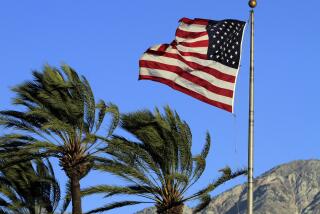The Mother of Los Ninos: Great Flood of ’38
- Share via
Sixty years ago this month a massive flood swept Orange County with a destructive force that makes El Nino look muy pequeno.
Many slept as the Santa Ana River breached its banks and overflowed into northern and western Orange County.
Thundering water toppled bridges, chewed up streets and uprooted railroad tracks. Flooding overtook homes, barns, cars, fields and the people and animals who occupied them.
“Dikes collapsed at 2:30 a.m. and within a half-hour the river had risen 5 feet and was racing through the city,” the Los Angeles Times reported from Anaheim which along with nearby Atwood, was hardest hit. “Water was 3 feet deep in many homes and residents found refuge on house tops. . . . More than a score of homes were demolished and almost every structure in the city was damaged.”
The Great Flood of 1938 remains the worst weather-related disaster in Orange County history. Runoff in the San Bernardino Mountains and days of rain caused the Santa Ana River to overflow.
Fifty-eight people died, 2,000 were left homeless and $12 million in damage was reported. The county, which had a population of only a bit more than 100,000, reported millions of dollars in damage from Fullerton to Huntington Beach.
Not all heard the police warning signals around midnight March 3, and some who did could not escape.
Farm workers stationed on low, flat land were hit the worst and accounted for much of the death toll. A mother from Anaheim was swept about a mile from her home and found dead with her baby in her arms. Bridges were destroyed along Pacific Coast Highway. Rail service was disrupted. School was canceled.
“We were isolated,” Orange County historian Jim Sleeper, 72, of Tustin said. “It took a month to find all of the bodies. . . . People were stranded on housetops, all kinds of rescues were made by boats. We didn’t have much in the way of emergency services.”
A teenager at the time, Lorraine Macias, 74, of Anaheim recalled the catastrophe.
“We left that evening when the water was up to our waist,” she said. “The only thing that saved our home is it was built on concrete blocks, like they did in those days, so the water pushed through.”
Macias remembers setting her 14-year-old eyes on the aftermath.
“Automobiles were stacked up like so much kindling wood,” she said. “Animals, you just lost them. They were swept on with everything else.”
Hope endured and good deeds were common. A woman in labor was taken by boat to a hospital, where she delivered.
Lecil Slavack, 85, of Anaheim remembers that his future wife was visiting from what is now Westminster but couldn’t return home. They married a year later.
“I remember we drove through Anaheim the next day and the water was up to the running boards,” he recalled. “We just drove through water. It wasn’t like a flowing river, it was standing water every place.”
To ensure this wouldn’t happen again, Prado Dam was built near Corona about a year later.
More to Read
Sign up for Essential California
The most important California stories and recommendations in your inbox every morning.
You may occasionally receive promotional content from the Los Angeles Times.








